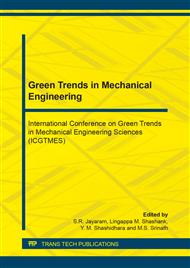p.272
p.278
p.284
p.290
p.295
p.301
p.307
p.313
p.319
Effect of Process Parameters on Depth of Penetration & Surface Roughness in Abrasive Waterjet Cutting of Copper
Abstract:
This study evaluates the effect of process parameters on depth of penetration and surface roughness in abrasive waterjet (AWJ) cutting of copper. Full factorial experiments are carried out on trapezoidal blocks for each of the three abrasive particle sizes used. Experimental parameters - abrasive mass flow rate, water jet pressure and traverse speed are varied at three levels. Main effects and contributions of process parameters to depth of penetration and surface roughness is calculated. From the data, it is observed that, high abrasive mass flow rate, high water jet pressure and low traverse speed resulted in higher depth of penetration and a high abrasive mass flow rate, high water jet pressure and low traverse speed resulted in lesser Ra value. Using experimental data a statistical model for predicting depth of penetration & surface roughness is developed. Error between experimental and statistical values are compared to validate the statistical model. The maximum DOP of 49.32mm was observed at AMFR=405.4 g/min, P=300 MPa, TS=60 mm/min, MS=60 Mesh and minimum DOP of 4.27mm was observed at AMFR=200 g/min, P=100 MPa, TS=90 mm/min, MS=80 Mesh.
Info:
Periodical:
Pages:
301-306
Citation:
Online since:
November 2019
Authors:
Price:
Сopyright:
© 2019 Trans Tech Publications Ltd. All Rights Reserved
Share:
Citation:


